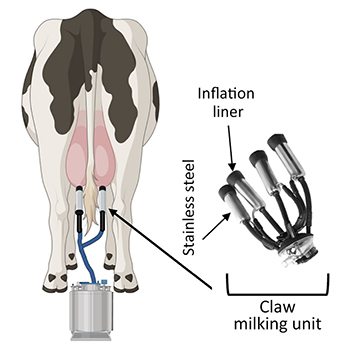
With the spread of bird flu, or H5N1 virus, to dairy cattle, new research from the University of Pittsburgh School of Medicine and Emory University in the journal Emerging Infectious Diseases shows that the virus remains stable on commercial milking equipment for at least one hour, increasing its potential to infect people and other animals.
“Our data supports that milking equipment surfaces can stay contaminated for a long time, increasing the potential spread from a sick animal to a person,” said lead author Valerie Le Sage, research assistant professor of microbiology and molecular genetics with Pitt’s Center for Vaccine Research.
 “These findings underscore the importance of face shields, masks and eye protection, and enhanced sanitization of equipment between cows to reduce the risk to workers and to minimize the spread between the animals.”
“These findings underscore the importance of face shields, masks and eye protection, and enhanced sanitization of equipment between cows to reduce the risk to workers and to minimize the spread between the animals.”
To understand the potential for spread from cattle to dairy farm workers, researchers looked at the stability of infectious flu virus particles in unpasteurized milk droplets on metal and rubber components of commercial milking equipment.
Their findings underscore the heightened risk of bird flu exposure for dairy farm workers.
Clinical symptoms of bird flu can range from mild fever and cough to shortness of breath and pneumonia and can be lethal. Since March 2024, when the bird flu virus was first detected in dairy cattle in the United States, the virus has spread across state lines and infected at least three people. According to the U.S. Centers for Disease Control and Prevention, the current risk to the general public remains low, but flu viruses can quickly adapt to spreading from person to person.
Other authors of this research are Douglas Reed and Paul Duprex, both of Pitt; and A.J. Campbell and Seema Lakdawala, both of Emory University.
This research was supported in part by the Department of Health and Human Services (Contract No. 75N93021C00015) and the National Institute of Allergy and Infectious Diseases supporting the operations of Pitt’s Regional Biocontainment Laboratory within the Center for Vaccine Research (UC7AI180311).
Image (left) caption: Schematic created in BioRender (https://www.biorender.com) by Le Sage et al
Photo courtesy of Valerie Le Sage
